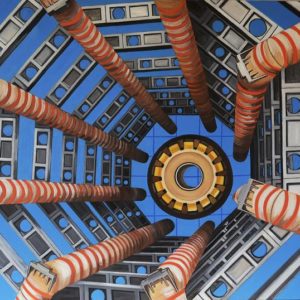One to Watch
 Sheefali Asija: Catalyzing Cooperation Through Art
Sheefali Asija: Catalyzing Cooperation Through Art
Sheefali Asija captures the sublimity of colossal pieces of technology—the Large Hadron Collider, Saturn V rockets, Tokamak nuclear fusion reactors—as a celebration of humanity’s collective achievements. Much like the sacred architecture of the past, these scientific feats have the power to inspire collective optimism and wonder. Sheefali draws on the aesthetics of machinery and translates their intricate designs to large-scale paintings that, upon first glance, recall the radial symmetry of Gothic rose windows or Buddhist mandalas. In the age of devastating climate change and post-truth politics, Sheefali urges us towards scientific education and global cooperation.
Sheefali holds an MFA from Chelsea College of Arts in London. She has exhibited her work in New York, Miami, London, and Vienna. Named a 2019 Saatchi Art Rising Star, Sheefali’s upcoming projects aim to bring art and science to the public.
1. Tell us about who you are and what you do. What’s your background?
I am a London-based artist from India. As an artist, I am inspired and informed by the world that science has revealed to us and that technology has provided for us. I believe that for humanity to have a prosperous future, it is critical to understand how we know what we know and how we got to where we are today. It is this knowledge that will enable us to rise to the immense challenges that we are presented with as a species.
In my recent work I have drawn on the Apollo space program of the 1960s and 1970s for inspiration, both from a visual and philosophical perspective. Neil Armstrong’s words spoken at 3.17 pm CST on 20th July, 1969, “Houston, Tranquility Base here. The Eagle has landed,” sent a cheer that reverberated around the world, and for one priceless moment in the whole history of man all the people on this Earth [were] truly one.
We had left the planet that gave birth to us and travelled to another world. In my mind this was humanity’s greatest secular “religious” moment and represented our greatest achievement as a species. It is that cheer—that sense of shared destiny and accomplishment achieved through cooperation, planning, understanding, sacrifice and ingenuity—that I explore with my art.
2. What series or artistic project are you working on next?
I have been selected by Guys and St Thomas’ National Health Service Trust to create large-scale public art installations across five locations around London to celebrate, on the bicentenary of her birth, Florence Nightingales’ evidence-based world view, her pioneering scientific and administrative work, and social reforms. In addition, I am collaborating with Dr. Winfried Hensinger, a leader in the field of quantum computing, and ideaXme to create a series of works which will be showcased in the new Super Quantum Lab in Brighton, UK. I am also preparing new work for my solo show towards the end of the year.
3. Who are your biggest influences and why?
My practice has been greatly shaped by the books of Richard Feynman, a professor of theoretical physics; David Grinspoon, a planetary scientist and astrobiologist; the art historian EH Gombrich; and the art of Kara Walker and David Hockney. Feynman believed the beauty of science could outweigh what any poet or painter might ever imagine about the world – the deeper our knowledge of any question, the greater our enjoyment can be. David Grinspoon makes the case for humanity to become graceful planetary engineers, conscious shapers of our environment and caretakers of Earth’s biosphere.
I find the ambition, poetry and confidence of Kara Walker as she explores race, black history, gender and violence extremely inspirational and humbling. Her appropriation of cultural motifs from the ‘traditional’ historical narrative and her subversion of those motifs is an approach that I have also explored in my work.
I also love David Hockney’s monumentally scaled works—they certainly influenced my desire to create ever larger pieces!
4. How does your work comment on current social or political issues?
Today humanity faces monumental challenges: how to prevent catastrophic climate change, how to stop the disastrous pollution of the environment, how to ensure that we continue our progress towards gender, sexual and racial equality continues. Addressing these challenges will require global collaboration, global investment in technology and global changes in our behaviour and outlook towards each other and towards the environment.
In the face of the shrill cacophony that often characterizes today’s political rhetoric, where facts are misrepresented and tribal interests are prioritized over global needs, the celebration of a fact-based world-view has never been more essential. I explore this concept of “conditional optimism” with my work in an effort to confront the dominant narratives of pessimism and fear and instead point to the astonishing human progress that can be achieved through knowledge, perseverance, cooperation and sacrifice.
Love reading about all things art? You can have articles from Canvas, curated collections, and stories about emerging artists delivered straight to your inbox. Sign up for the Saatchi Art Newsletter.
















